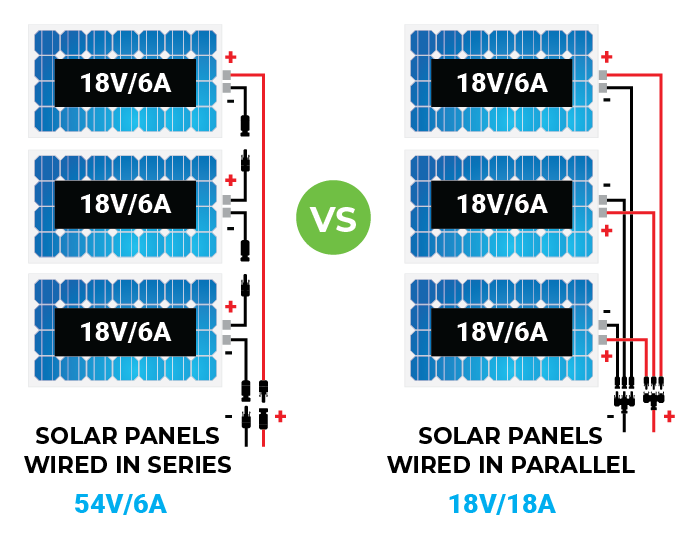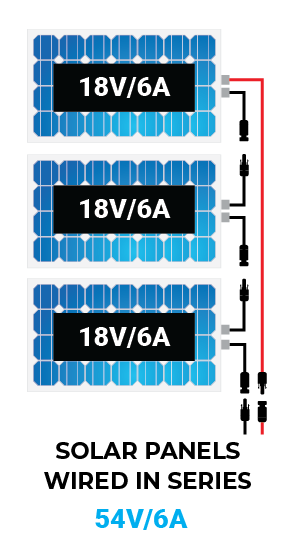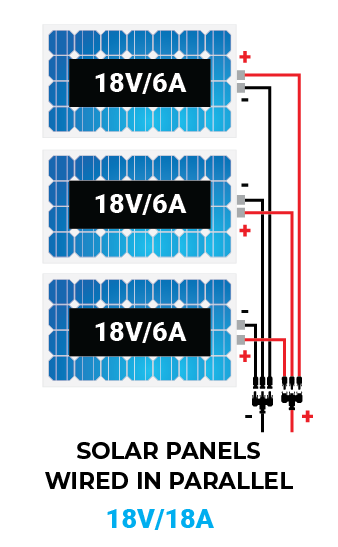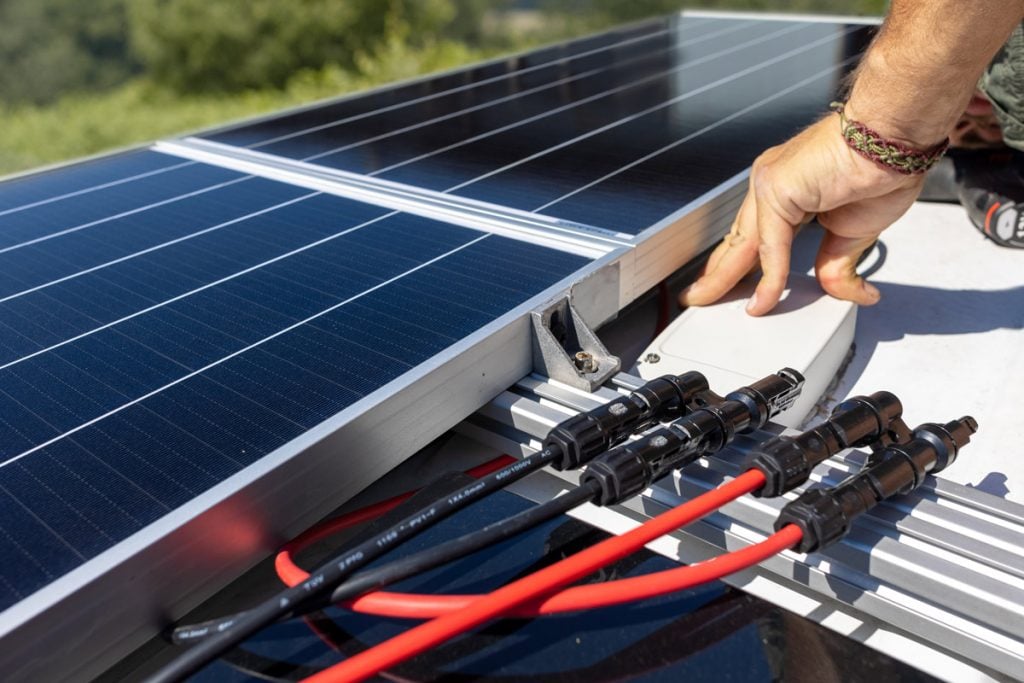RV Solar Panels: Series vs Parallel Wiring Pros and Cons
If you’re considering outfitting your RV with solar panels, you might be wondering whether it’s better to wire them in series or parallel. After all, how do you know what kind of wiring will give you the best performance?
The answer depends on a few factors. In this article, we’re going to give you the pros and cons of wiring your solar panels in both series and parallel so you can decide which is right for your RV set-up or DIY camper van build.

Overview
Let’s start with an overview of the two:
- Series wiring connects multiple panels together in a line, allowing electricity to flow through them one after another like a string of Christmas lights. This increases the voltage but keeps the amperage the same.
- Parallel wiring runs all of the positive wires into one combiner, and all of the negative wires into another combiner. This keeps the voltage the same but increases the amperage.
Wiring in Series Example
Wiring RV solar panels in series is the cheaper and more flexible option. Higher voltage rather than amperage means that you will have smaller wires and more resiliency in different shading scenarios.
You can envision it like stringing up several panels in a row to make one big panel.

In this example, 3x100W solar panels with 18 volts and 6 amps of power are wired in series.
This gives you a total of 54 volts and 6 amps of power.
Wiring in Parallel Example
Wiring solar panels in parallel can be more intuitive (all red wires together, all black wires together). This is a good choice if your other solar components can’t handle high voltage. For example, if your charge controller is only limited to 24V input, you wouldn’t want to series wire panels to give 48V input.

In this example, 3x100W solar panels with 18 volts and 6 amps of power are wired in parallel.
This gives you a total of 18 volts and 18 amps of power.
Shade Conditions
On overcast days, or in low-light situations, series wiring is the best. This is because if a single panel is shaded it doesn’t limit the voltage of the whole string. You still get the full output of the rest of the panels.
It can also make use of very little sun because each panel’s voltage is added together, making it more likely to meet the minimum voltage needed to charge your batteries.
If you use parallel wiring, then any panel that’s in the shade will limit the overall electricity output.
Wire Size
Parallel solar needs bigger wiring, fuses, and combiners. Each panel must be fused at the combiner junction in case one shorts out. The wiring must be bigger as you are increasing amps.
Charge Controller Type
If you use an MPPT charge controller, it’s best to wire your solar panels in series to get the highest voltage the controller can accept. This will provide the highest voltage possible and ensure the most efficient charging of your batteries.
However, if you’re using a PWM charge controller, then parallel wiring is recommended as it will provide the highest current possible.
- Read this post on RV charge controllers to learn more.
Battery Type
Another factor to consider is the type of batteries you are using. If your RV has deep cycle batteries, then series wiring may be better for you as it allows the charge controller to increase the voltage at certain parts of the charge cycle.
Parallel wiring works well if you have regular lead-acid batteries since it allows you to easily control the charge and discharge cycles (although series works here too).
- Read this post on RV batteries to learn more.
System Size
So, which is better? It depends on the type of set-up you have in your RV. If you have a small system with only a few panels, then series wiring is often the preferred option because it will increase the voltage output and provide more energy in total.
On the other hand, larger systems with more panels will benefit from parallel wiring as it increases the current output and provides more power.
Cost
Finally, if you’re looking for a way to save money on wiring costs, then parallel wiring may be the best option for you.
Series wiring requires more cable and connectors, which can significantly increase your installation costs.
Parallel wiring, on the other hand, only requires one cable to connect all of the panels together, which helps keep costs down.

Combining Series and Parallel Wiring
You can also wire RV solar panels in a combination of series and parallel. How does it work? You need an even number of panels to start with, then you can use benefits of both types of wiring when designing your system.
This is beneficial if you have voltage limits in other parts of your equipment.
For example, if you have six panels and stringing them all up in series is too much voltage for your charge controller to handle, you don’t have to default to wiring them all up in parallel.
Stringing panels in series essentially creates “one” larger panel. So, you can wire two panels in series, then do that two more times to “create” three big panels. Then wire those three sets of panels in parallel. This gives you 1/3 the voltage but still some benefits of series wiring.
FAQs
What is the difference between series and parallel wiring?
Series wiring connects each solar panel in a line, with the current flowing from one to the next. Parallel wiring connects all of the panels together at one point, with each panel connected individually.
Can I mix panels with different wattages in a single string?
Yes, you can mix different wattage panels in the same string. However, it’s important to make sure you don’t exceed the maximum amperage rating of your charge controller. Doing so could cause damage to your system and increase safety risks.
Which is safer series or parallel?
Both series and parallel wiring are equally safe when installed correctly. However, it’s important to make sure you use the right cables and connectors to ensure your system is properly protected against shorts. It’s also important to keep an eye on the voltage levels of each panel in order to avoid overloading them.
What is the advantage of connecting solar panels in series?
Series wiring helps to reduce the amount of stress on each cell in a deep cycle battery, resulting in better efficiency and longer battery life. It also allows for higher voltage levels which can help maximize the charging potential of your batteries.
What is the advantage of connecting solar panels in parallel?
Parallel wiring is often more cost effective than series wiring since it requires fewer cables and connectors. It also allows for better voltage control as each panel can be individually controlled and monitored. This makes it easier to keep an eye on the charge and discharge cycles of your system.
Which is best?
In our opinion, wiring in series should be the go-to setup due to less complexity and higher efficiency. If you’ve got a small system and PWM controller, then wiring in parallel is better – just make sure you fuse everything properly.
At the end of the day, it all comes down to your own personal situation and preferences. Series and parallel wiring each have their own sets of advantages and disadvantages, so it’s important to evaluate what will work best for your RV before making a decision.
With the right set-up, you can maximize the efficiency of your RV’s solar system and get the most out of it. Good luck!
